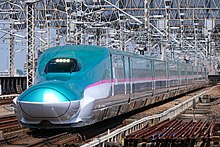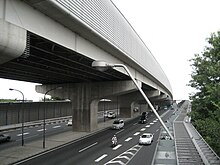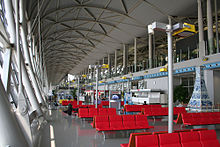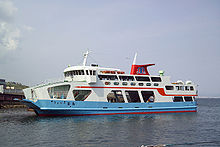Transportation in South Korea is provided by extensive networks of railways, highways, bus routes, ferry services and air routes that traverse the country. South Korea is the third country in the world to operate a maglev train, which is an automatically run people mover at Incheon International Airport.
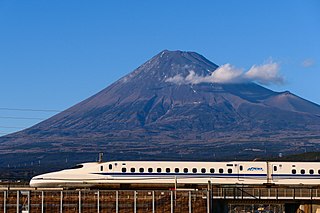
High-speed rail (HSR) is a type of rail transport network utilizing trains that run significantly faster than those of traditional rail, using an integrated system of specialized rolling stock and dedicated tracks. While there is no single standard that applies worldwide, lines built to handle speeds above 250 km/h (155 mph) or upgraded lines in excess of 200 km/h (124 mph) are widely considered to be high-speed.
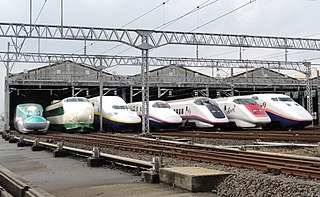
The Shinkansen, colloquially known in English as the bullet train, is a network of high-speed railway lines in Japan. Initially, it was built to connect distant Japanese regions with Tokyo, the capital, to aid economic growth and development. Beyond long-distance travel, some sections around the largest metropolitan areas are used as a commuter rail network. It is owned by the Japan Railway Construction, Transport and Technology Agency and operated by five Japan Railways Group companies.

Kansai International Airport, commonly known as 関空, is the primary international airport in the Greater Osaka Area of Japan and the closest international airport to the cities of Osaka, Kyoto, and Kobe. It is located on an artificial island in the middle of Osaka Bay off the Honshu shore, 38 km (24 mi) southwest of Ōsaka Station, located within three municipalities, including Izumisano (north), Sennan (south), and Tajiri (central), in Osaka Prefecture. The airport's 1st airport island covers approximately 510 hectares and the 2nd airport island covers approximately 545 hectares, for a total of 1,055 hectares.

The West Japan Railway Company, also referred to as JR West, is one of the Japan Railways Group companies and operates in western Honshu. It has its headquarters in Kita-ku, Osaka. It is listed in the Tokyo Stock Exchange, is a constituent of the TOPIX Large70 index, and is also one of only three Japan Railways Group constituents of the Nikkei 225 index: the others are JR East and JR Central. It was also listed in the Nagoya and Fukuoka stock exchanges until late 2020.

The Tōkaidō Main Line is a major Japanese railway line of the Japan Railways Group network, connecting Tokyo and Kōbe stations. It is 589.5 km (366.3 mi) long, not counting its many freight feeder lines around the major cities. The high-speed Tōkaidō Shinkansen largely parallels the line.

The Central Japan Railway Company is the main railway company operating in the Chūbu (Nagoya) region of central Japan. It is officially abbreviated in English as JR Central and in Japanese as JR Tōkai. Tōkai is a reference to the geographical region in which the company chiefly operates.

The Tōkaidō Shinkansen is a Japanese high-speed rail line that is part of the nationwide Shinkansen network. Along with the Sanyo Shinkansen, it forms a continuous high-speed railway through the Taiheiyō Belt, also known as the Tokaido corridor. Opening in 1964, running between Tokyo and Shin-Ōsaka, it is the world's first high-speed rail line. Along with being the world's first high-speed rail line, it is also one of the most heavily used. Since 1987 it has been operated by the Central Japan Railway Company, prior to that by Japanese National Railways (JNR).

Kobe Airport is an airport on an artificial island just off the coast of Kobe, 8 km (5.0 mi) south of Sannomiya Station Japan. Opened on February 16, 2006, it primarily handles domestic flights, but can also accommodate international charter flights. In the first year of operation (2006), the airport handled 2,697,000 passengers with an average load factor of 61.1%. In 2017, it handled 3,071,974 passengers with an average load factor of 79.4%. In the fiscal year covering April 2022-March 2023, UKP had a pax throughput of 3,109,151. The island airport covers just 156 hectares of land.

The Chuo Shinkansen is a Japanese maglev line under construction between Tokyo and Nagoya, with plans for extension to Osaka. Its initial section is between Shinagawa Station in Tokyo and Nagoya Station in Nagoya, with stations in Sagamihara, Kōfu, Iida and Nakatsugawa. Following the completion of the Tokyo-Nagoya line, the line will extend to connect stations in Mie, Nara and Osaka. The line is expected to connect Tokyo and Nagoya in 40 minutes, and eventually Tokyo and Osaka in 67 minutes, running at a maximum speed of 505 km/h (314 mph). About 90% of the 286-kilometer (178 mi) line to Nagoya will be tunnels.
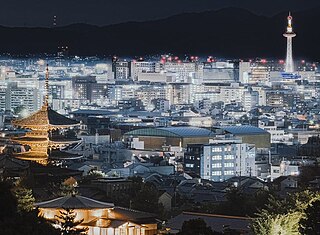
Keihanshin is a metropolitan region in the Kansai region of Japan encompassing the metropolitan areas of the cities of Kyoto in Kyoto Prefecture, Osaka in Osaka Prefecture and Kobe in Hyōgo Prefecture. The entire region has a population of 19,302,746 over an area of 13,228 km2 (5,107 sq mi). It is the second-most-populated urban region in Japan, containing approximately 15% of Japan's population.

Hiroshima Airport is an international airport in the city of Mihara, Hiroshima Prefecture, Japan. Located 50 km (31 mi) east of Hiroshima, it is the largest airport in the Chūgoku region.
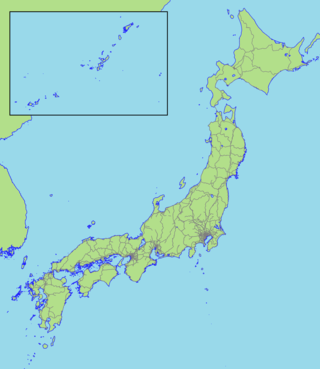
Rail transport in Japan is a major means of passenger transport, especially for mass and high-speed travel between major cities and for commuter transport in urban areas. It is used relatively little for freight transport, accounting for just 0.84% of goods movement. The privatised network is highly efficient, requiring few subsidies and running with extreme punctuality, though since privatisation several unprofitable but socially valuable lines have been closed by private operators.

The SCMaglev is a magnetic levitation (maglev) railway system developed by Central Japan Railway Company and the Railway Technical Research Institute.

The transport network in Greater Tokyo includes public and private rail and highway networks; airports for international, domestic, and general aviation; buses; motorcycle delivery services, walking, bicycling, and commercial shipping. While the nexus is in the central part of Tokyo, every part of the Greater Tokyo Area has rail or road transport services. There are also a number of ports offering sea and air transport to the general public.

Shizuoka Airport, also called Mt. Fuji Shizuoka Airport, is located in Shizuoka Prefecture, Japan. Opened on June 4, 2009, the airport has domestic service to Sapporo, Fukuoka, Naha (Okinawa), Komatsu, Kumamoto, and Kagoshima. International routes connect it to Ningbo, Seoul, Taipei, and Shanghai.
Transport in the Keihanshin metropolitan region is much like that of Tokyo: it includes public and private rail and highway networks; airports for international, domestic, and general aviation; buses; motorcycle delivery services, walking, bicycling, and commercial shipping. The nexus is in the central part of Osaka, though Kobe and Kyoto are major centers in their own right. Every part of Keihanshin has rail or road transport services. The sea and air transport is available from a limited number of ports for the general public.

Osaka International Airport, often referred to as Itami Airport is the primary regional airport for the Kansai region of Japan, including the major cities of Osaka, Kyoto and Kobe. Classified as a first class airport, it is the airport closest to Kyoto, 36 kilometres (22 mi) southwest of Kyoto Station. Itami Airport has a small footprint, covering only 311 hectares of land.

Transport in Greater Nagoya (Chūkyō) is similar to that of the Tokyo and Osaka, but is more automobile oriented, as the urban density is less than Japan's two primary metropolises, and major automobile manufacturers like Toyota are based here. Still, compared to most cities of its size worldwide it has a considerable rail transport network with 3 million passenger trips daily, with a similar density and extent of passenger rail to London or New York City, complemented with highways and surface streets for private motor transport. It includes public and private rail and highway networks; airports for international, domestic, and general aviation; buses; motorcycle delivery services, walking, bicycling, and commercial shipping. The nexus of the public transport system is Nagoya Station. Every region of Greater Nagoya, also known as the Chūkyō Metropolitan Area (中京圏), has rail or road transport services, and the area as a whole is served by sea and air links.
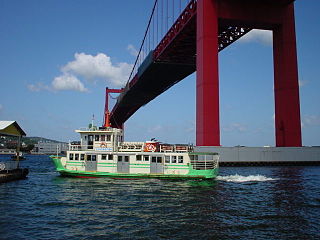
Transport in Fukuoka-Kitakyushu is similar to that of other large cities in Japan, but with a high degree of private transport. The region is a hub of international ferry services and has a high degree of air connectivity and a considerable rail transport network, complemented with highways and surface streets. It includes public and private rail and highway networks; airports for international, domestic, and general aviation; buses; motorcycle delivery services, walking, bicycling, and commercial shipping. The foci of the public transport system are Hakata Station, Tenjin Station, and Kokura Station, in Fukuoka and Kitakyushu cities respectively. Between these two cities lies a more sparse weblike regional rail network.
